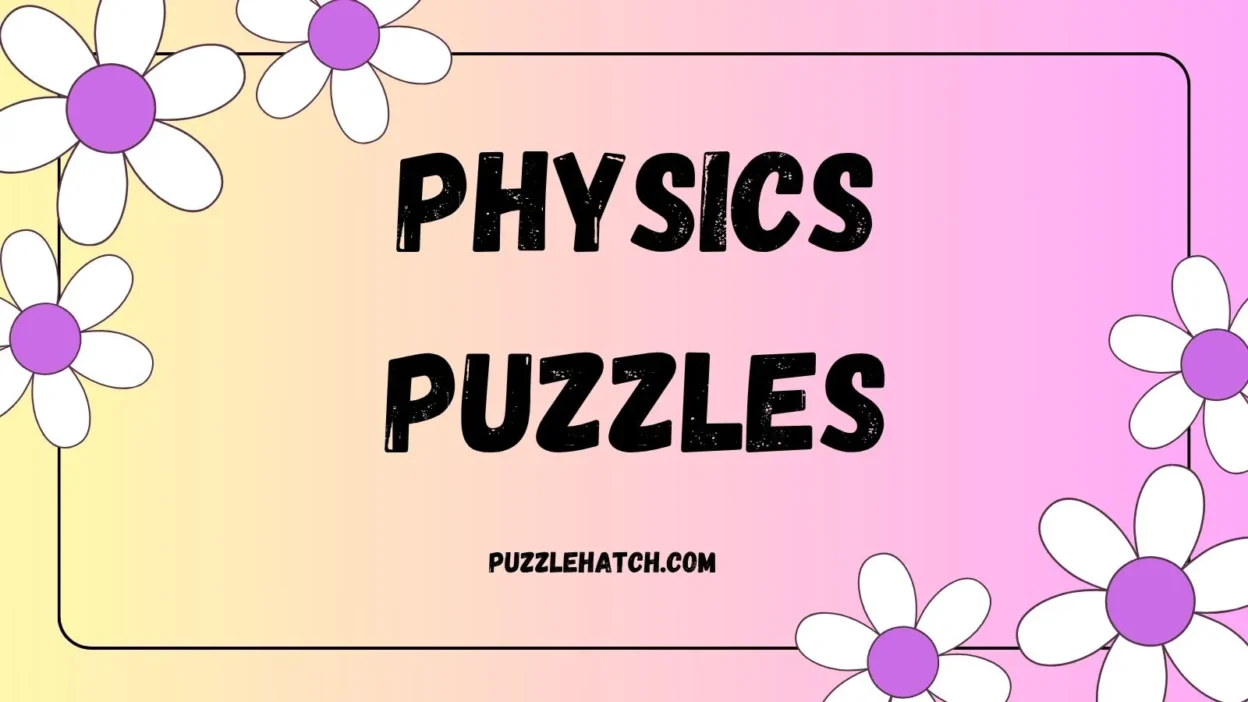Welcome to the world of “Quantum Quests: 350+ Physics Puzzles 2025”—where science meets fun and curiosity becomes your guide. In this thrilling collection, we blend the mystery of quantum mechanics with engaging, brain-teasing riddles and puzzles.
Whether you’re a physics student, a teacher looking for classroom activities, or simply a science enthusiast, these physics-based puzzles will challenge your mind and strengthen your understanding of the laws that govern our universe.
This isn’t just another riddle collection—this is a deep dive into the world of particles, forces, energy, motion, waves, electromagnetism, and everything else under the physics umbrella.
Quantum Mechanics Riddles and Puzzles
- I’m everywhere and nowhere at once. Collapse me with a glance. What am I?
Answer: A quantum superposition - What’s a cat doing alive and dead at the same time?
Answer: Living in Schrödinger’s thought experiment - I spin, but not like a top. I’m a property, not a motion.
Answer: Quantum spin - Which particle can pass through walls like a ghost?
Answer: A neutrino - What kind of leap do electrons make when excited?
Answer: A quantum leap - I limit how much you can know about speed and position.
Answer: Heisenberg’s Uncertainty Principle - I’m entangled across the galaxy, yet instantaneously connected.
Answer: Quantum entanglement - What’s the smallest possible packet of energy?
Answer: A quantum - I calculate probabilities, not certainties.
Answer: A wave function - Which dual nature causes light to behave strangely?
Answer: Wave-particle duality
Classical Mechanics Brain Teasers
- What law tells you that every action has a reaction?
Answer: Newton’s Third Law - If you drop two objects from a height in a vacuum, which lands first?
Answer: They land at the same time - What force keeps a satellite in orbit?
Answer: Gravity (centripetal force) - What’s measured in meters per second squared?
Answer: Acceleration - Why do you feel pressed back in your seat during acceleration?
Answer: Inertia - What kind of friction keeps a book from sliding off a table?
Answer: Static friction - What is mass times velocity called?
Answer: Momentum - I resist changes in motion. What am I?
Answer: Inertia - What happens when net force is zero?
Answer: The object remains at constant velocity - What causes an apple to fall from a tree?
Answer: Gravitational force
Thermodynamics and Heat Puzzles
- What is the tendency of systems to move toward disorder?
Answer: Entropy - Which law states that energy cannot be created or destroyed?
Answer: First Law of Thermodynamics - Why does ice melt faster on metal than plastic?
Answer: Metal conducts heat better - What’s the measure of molecular motion?
Answer: Temperature - What flows from hot to cold spontaneously?
Answer: Heat - I describe the amount of energy available to do work.
Answer: Free energy - What is absolute zero in Kelvin?
Answer: 0 K - What phase change absorbs heat but feels cold?
Answer: Evaporation - I prevent heat flow between systems.
Answer: Thermal insulation - What do you call energy in transit due to temperature difference?
Answer: Heat transfer
Electricity and Magnetism Riddles
- What flows in a closed circuit?
Answer: Electric current - What causes a compass needle to move near a wire?
Answer: Magnetic field from current - What unit is used for electric potential?
Answer: Volt - What is resistance measured in?
Answer: Ohms - I oppose current flow. What am I?
Answer: Resistor - Which law connects voltage, current, and resistance?
Answer: Ohm’s Law - I store electric charge. What am I?
Answer: Capacitor - Which device converts mechanical energy to electrical?
Answer: Generator - What causes lightning during storms?
Answer: Static discharge - Who discovered electromagnetic induction?
Answer: Michael Faraday
Optics and Light-Based Riddles
- What bends when entering a new medium?
Answer: Light (refraction) - What happens when light bounces off a mirror?
Answer: Reflection - What breaks white light into a rainbow?
Answer: Prism - What’s the speed of light in a vacuum?
Answer: 299,792,458 m/s - What is the phenomenon where waves overlap and combine?
Answer: Interference - What happens in the double-slit experiment?
Answer: Light shows interference pattern - What part of the eye focuses light?
Answer: Lens - Which light has the highest frequency?
Answer: Gamma rays - What’s the phenomenon where light changes direction around obstacles?
Answer: Diffraction - Which wave property lets glasses block sunlight?
Answer: Polarization
Waves and Sound Puzzles
- What’s a vibration that moves through a medium?
Answer: A wave - What do we call wave height?
Answer: Amplitude - What kind of wave is sound?
Answer: Longitudinal wave - What determines pitch in sound?
Answer: Frequency - Why does sound travel faster in solids?
Answer: Molecules are closer together - What do echoes demonstrate?
Answer: Reflection of sound - What unit measures frequency?
Answer: Hertz - What is it called when two frequencies combine destructively?
Answer: Interference - Why do you hear a siren change pitch as it passes?
Answer: Doppler Effect - What’s created when waves line up?
Answer: Constructive interference
Relativity Puzzles
- What happens to time as you move faster?
Answer: Time dilation - What shortens in length when you move at near light speed?
Answer: Length contraction - What remains constant in all frames of reference?
Answer: Speed of light - What is E=mc² describing?
Answer: Mass-energy equivalence - What causes gravity in general relativity?
Answer: Curved spacetime - Who formulated Special and General Relativity?
Answer: Albert Einstein - What do GPS satellites account for?
Answer: Relativistic time differences - What stretches space and time?
Answer: Massive objects - What slows near a black hole?
Answer: Time - What do observers disagree on in special relativity?
Answer: Simultaneity
Modern Physics and Particle Riddles
- What’s the particle of light?
Answer: Photon - What’s the antimatter twin of an electron?
Answer: Positron - What holds the nucleus together?
Answer: Strong nuclear force - Which force is responsible for radioactive decay?
Answer: Weak nuclear force - What kind of particle cannot be broken down further?
Answer: Fundamental particle - What’s the “God Particle”?
Answer: Higgs boson - What causes mass in particles?
Answer: Higgs field - Which model explains subatomic particles?
Answer: Standard Model - What particle has no charge and nearly no mass?
Answer: Neutrino - What accelerates particles to near light speed?
Answer: Particle accelerator
Forces and Motion Challenges
- What keeps you pinned to the Earth’s surface?
Answer: Gravity - What causes a ball to roll down a slope?
Answer: Unbalanced force - What type of force opposes motion through air?
Answer: Air resistance - Why does a car need more force to speed up quickly?
Answer: Greater acceleration requires greater force (Newton’s Second Law) - What is the rate of change of velocity?
Answer: Acceleration - What happens when you remove all friction?
Answer: Constant velocity continues indefinitely - What’s the net force if two equal forces act in opposite directions?
Answer: Zero - What causes a roller coaster to speed up going downhill?
Answer: Gravitational force - Which quantity includes both speed and direction?
Answer: Velocity - Why does a seatbelt help in a crash?
Answer: Prevents inertia from flinging you forward
Energy and Work Puzzles
- What’s energy in motion called?
Answer: Kinetic energy - What kind of energy is stored in a stretched rubber band?
Answer: Potential energy (elastic) - What unit measures work done?
Answer: Joules - What’s the formula for work?
Answer: Force × distance - What kind of energy transformation occurs in a toaster?
Answer: Electrical to thermal energy - What’s it called when energy moves from one object to another?
Answer: Energy transfer - What’s conserved in a closed system?
Answer: Total energy - What type of energy powers a moving pendulum?
Answer: Mechanical energy - What form of energy is stored in food?
Answer: Chemical energy - What energy source comes from the sun?
Answer: Solar energy (radiant)
Astronomy and Astrophysics Riddles
- What’s a massive sphere of gas undergoing fusion?
Answer: Star - What keeps planets in orbit?
Answer: Gravity from the sun - What’s a star’s life-ending explosion called?
Answer: Supernova - What do black holes bend?
Answer: Spacetime and light - What is Earth’s natural satellite?
Answer: The Moon - What’s the nearest star to Earth?
Answer: The Sun - What tool lets us see distant galaxies?
Answer: Telescope - What is cosmic background radiation a remnant of?
Answer: The Big Bang - What invisible matter adds to galactic mass?
Answer: Dark matter - What expands faster than light after the Big Bang?
Answer: The early universe (cosmic inflation)
Nuclear Physics Puzzles
- What process powers the sun?
Answer: Nuclear fusion - What is nuclear splitting called?
Answer: Nuclear fission - What is emitted in radioactive decay?
Answer: Radiation (alpha, beta, gamma) - What particle has no charge but high mass?
Answer: Neutron - What protects us from radiation in nuclear plants?
Answer: Lead shielding - What unit measures radiation dose?
Answer: Sievert - What causes radioactive atoms to decay?
Answer: Nuclear instability - What keeps protons from repelling in the nucleus?
Answer: Strong nuclear force - What radioactive element powered early submarines?
Answer: Uranium-235 - What device measures radioactivity?
Answer: Geiger counter
Fluid Mechanics Riddles
- What principle explains why ships float?
Answer: Archimedes’ principle - What property causes surface tension?
Answer: Cohesion of molecules - What’s the upward force in a fluid called?
Answer: Buoyant force - What law explains pressure increase with depth?
Answer: Pascal’s Law - What fluid property resists flow?
Answer: Viscosity - What causes lift in an airplane wing?
Answer: Bernoulli’s principle - Why do helium balloons rise?
Answer: Helium is less dense than air - What’s a unit for measuring fluid pressure?
Answer: Pascal - What happens to pressure as volume decreases (in gases)?
Answer: It increases (Boyle’s Law) - What’s turbulent flow compared to?
Answer: Chaotic and irregular motion
Simple Machines and Mechanics Riddles
- What simple machine is a seesaw?
Answer: Lever - What multiplies force with a wheel and rope?
Answer: Pulley - What tool reduces friction in rotation?
Answer: Ball bearing - What is a screw an example of?
Answer: An inclined plane - What machine is a knife blade?
Answer: Wedge - What reduces effort needed to lift something?
Answer: Mechanical advantage - What connects a fulcrum and a load?
Answer: Lever arm - What machine is a doorknob?
Answer: Wheel and axle - What machine raises water from a well?
Answer: Pulley system - What multiplies input force to output?
Answer: Simple machine
Measurement and Units Puzzles
- What’s the SI unit of force?
Answer: Newton - What’s mass measured in?
Answer: Kilograms - What instrument measures electric current?
Answer: Ammeter - What unit measures energy?
Answer: Joule - What’s used to measure time precisely?
Answer: Atomic clock - What’s temperature measured in globally?
Answer: Kelvin - What’s the standard unit of power?
Answer: Watt - What’s a nanosecond?
Answer: One billionth of a second - What measures light intensity?
Answer: Candela - What device measures atmospheric pressure?
Answer: Barometer
Engineering and Applied Physics Challenges
- What keeps skyscrapers stable during earthquakes?
Answer: Shock absorbers (dampers) - What converts solar energy to electricity?
Answer: Solar cell (photovoltaic) - What makes MRI machines work?
Answer: Strong magnetic fields - What principle is behind airbags?
Answer: Rapid gas expansion and impulse - What’s used to insulate spacecraft from heat?
Answer: Thermal shielding - What stabilizes drones mid-flight?
Answer: Gyroscope and accelerometer - What helps engineers predict failure?
Answer: Stress-strain analysis - What slows vehicles without touching them?
Answer: Magnetic braking - What is structural load-bearing tested by?
Answer: Compression testing - What scientific rule is applied in bridges?
Answer: Load distribution and torque
Quantum Computing and Information Riddles
- What’s the basic unit of quantum data?
Answer: Qubit - What property lets qubits be 0 and 1 simultaneously?
Answer: Superposition - What quantum feature ensures encryption security?
Answer: Entanglement - What algorithm breaks classical encryption faster?
Answer: Shor’s algorithm - What’s a major obstacle in quantum computing?
Answer: Decoherence - What field combines physics and information theory?
Answer: Quantum information science - What type of computer uses qubits?
Answer: Quantum computer - What device manipulates quantum states?
Answer: Quantum gate - What helps correct errors in qubit states?
Answer: Quantum error correction - What does a quantum circuit process?
Answer: Probabilistic computations
Experimental Physics and Lab Puzzles
- What measures temperature precisely in labs?
Answer: Digital thermometer or thermocouple - What lab tool accelerates particles?
Answer: Cyclotron - What does a spectrometer analyze?
Answer: Light spectrum - What’s a control variable used for?
Answer: Ensuring valid results - What measures tiny masses?
Answer: Analytical balance - What’s used to study collisions?
Answer: Air track - What ensures reliable results in experiments?
Answer: Repetition and accuracy - What converts physical quantities to signals?
Answer: Sensor or transducer - What captures high-speed events?
Answer: High-speed camera - What is peer review essential for?
Answer: Scientific validity
Environmental Physics and Renewable Energy Riddles
- What renewable source uses falling water to make power?
Answer: Hydroelectric energy - What green energy depends on air movement?
Answer: Wind energy - What device captures sunlight for power?
Answer: Solar panel - What physical principle is used in geothermal energy?
Answer: Heat transfer from Earth’s core - What emits no carbon but produces electricity?
Answer: Solar and wind power systems - What law applies when energy changes form in nature?
Answer: Conservation of energy - Why is solar energy considered sustainable?
Answer: It’s endlessly renewable and clean - What helps improve energy efficiency in homes?
Answer: Thermal insulation - What is the greenhouse effect caused by?
Answer: Trapped infrared radiation - What instrument measures solar irradiance?
Answer: Pyranometer
Everyday Physics and Real-World Riddles
- Why does your hand feel cold on metal but not wood?
Answer: Metal conducts heat faster - What physics concept explains why a bicycle stays upright?
Answer: Angular momentum - Why do your ears pop in an airplane?
Answer: Change in air pressure - Why do mirrors flip left-right but not up-down?
Answer: They reflect light perpendicularly - What causes a rainbow after rain?
Answer: Refraction and dispersion of sunlight - Why do you skid on ice?
Answer: Reduced friction - What keeps a spinning top balanced?
Answer: Gyroscopic stability - Why does a straw work in your drink?
Answer: Pressure difference (suction) - What keeps satellites from falling back to Earth?
Answer: Orbital velocity balances gravity - Why do clothes cling after drying?
Answer: Static electricity
Final Thought
Exploring physics through puzzles brings science to life in a way textbooks can’t. “Quantum Quests: 350+ Physics Puzzles 2025” isn’t just about solving riddles—it’s about connecting with the universe at the most fundamental level.
Whether you’re unraveling the mysteries of quantum particles or challenging gravity’s pull, each question takes you closer to understanding the fabric of reality. Embrace the challenge, ignite your curiosity, and let physics puzzle your brain into brilliance.
FAQs
What age group is this puzzle collection suitable for?
This collection is ideal for teens, students, educators, and science enthusiasts of all levels.
Are these puzzles aligned with current physics curriculum standards?
Yes, they cover foundational and advanced topics consistent with 2025 physics standards and topics.
Can these puzzles be used for classroom activities?
Absolutely. They are perfect for group discussions, quizzes, and educational fun.
Do I need prior knowledge of physics to enjoy the riddles?
Not at all—some puzzles are conceptual while others are challenging, catering to all levels.
Is this resource helpful for competitive exams?
Yes. The riddles help sharpen problem-solving and conceptual understanding useful in physics Olympiads and entrance exams.



